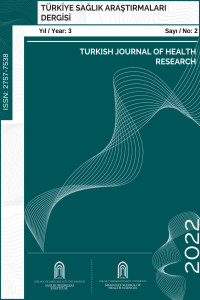Radyoterapi Tedavisinde Meme Kanseri Hastalarda Tomotherapy HI-ART ve Varian Trilogy Cihazlarında Hedef Volüm ve Kritik Organların Doz Değerlerinin Karşılaştırılması ve Değerlendirilmesi - Comparison and Evaluation of Target Volume and Dose Values of Critical Organs in Tomotherapy HI-ART and Varian Trilogy Devices in Breast Cancer Patients in Radiotherapy Treatment
Abstract
ÖZ
Amaç: Bu çalışmada sol meme kanserli hastaların, göğüs duvarı ve lenfatik bölge ışınlamasında Helikal ve IMRT Işınlama teknikleri kullanılarak tedavi planı yapıldı.
Meme kanseri; cerrahi, kemoterapi ve radyoterapi tedavi gibi tedavi yöntemleri ile yapılmaktadır. Meme koruyucu cerrahi işlem ile çıkarılan tümörün radyoterapi ile tamamlanmaktadır. Amaç PTV (Hedef volüm) ve kritik organ (akciğer, kalp ve LAD) dozlarını dozimetrik olarak karşılaştırılıp değerlendirilmesidir.
Yöntem: Bu çalışmada sol meme kanserli hastaların 2 ayrı cihazda Helikal ve IMRT Işınlama teknikleri kullanılarak tedavi planı yapıldı. Hedef hacim (PTV) için, Homojenite İndeksi (HI), Konformalite İndeksi (CI) hesaplandı. Risk altındaki organ (akciğer, kalp ve LAD) dozları incelendi. İki Cihaz arasında dozimetrik karşılaştırma yapıldı. İstatiksel analizde SPSS program kullanılarak p<0,05 için değerlere bakıldı.
Bulgular: Helikal Işınlama yönteminde %50 izodoz hacmi daha yüksek, sol akciğer V5 değeri, Kalp ve LAD (Left Anterior Descending) ortalama dozları daha düşük bulundu. IMRT ışınlama tekniğinde ise sağ akciğer V5, V20 ve sol akciğer V20 doz değerleri daha yüksek bulundu.
Sonuç: Kritik organ doz değeri Helikal Işınlama yönteminde sol akciğer V5, kalp ve LAD (Left Anterior Descending) ortalama doz değerleri daha düşüktür. IMRT Işınlama tekniğinde ise sağ akciğer ve sol akciğer V20 doz değerinin daha düşük olduğu bulundu.
Anahtar sözcükler: Meme kanseri, IMRT, Helikal Işınlama.
ABSTRACT
Aim: In this study, helical and IMRT planning planning plan in patients with left breast cancer, apparently can be considered and regional irradiation. Breast cancer; It is performed with treatment methods such as surgery, chemotherapy and radiotherapy treatment. The tumor removed by breast-conserving surgery is complemented by radiotherapy. The aim is to compare and evaluate PTV (Target volume) and critical organ (lung, heart and LAD) doses dosimetrically.
Methods: In this study, a treatment plan was made for patients with left breast cancer using Helical and IMRT Irradiation techniques on 2 separate devices. For target volume (PTV), Homogeneity (HI), Conformity Index (CI) were calculated. Doses of organs at risk (lung, heart and LAD) were examined. Dosimetric comparison was made between the two devices. In statistical analysis, values for p<0.05 were checked using the SPSS program.
Results: In the Helical Irradiation method, 50% isodose volume was higher, left lung V5 value, Heart and LAD mean doses were lower. In the IMRT irradiation technique, the dose values of the right lung V5, V20 and left lung V20 were found to be higher.
Conclusion: Critical organ dose value In Helical Irradiation method, left lung V5, heart and LAD mean dose values are lower. In the IMRT irradiation technique, the right lung and left lung V20 dose values were found to be lower.
Keywords: Breast Cancer, IMRT, Helical Irradiation.
Keywords
References
- 1. Çay F. Meme kanseri. In: İçli F(ed). Tıbbi Onkoloji. Antıp. Ankara. 1997; 167-173.
- 2. Becker-Schiebe M, Stockhammer M, Hoffmann W, Wetzel F, Franz H. (2016) Does mean heart dose sufficiently reflect coronary artery exposure in left-sided breast cancer radiotherapy Influence of respiratory gating. Strahlenther Onkol 192: 624–31.
- 3. Lind PA, Wennberg B, Gagliardi G, Fornander T. (2001) Pulmonary complications following different radiotherapy techniques for breast cancer, and the association to irradiated lung volume and dose. Breast Cancer Res Treat ;68(3):199–210.
- 4. Grantzau T, Mellemkjær L, Overgaard J. Second primary cancers after adjuvant radiotherapy in early breast cancer patients: a national population based study under the Danish Breast Cancer Cooperative Group (DBCG). Radiother Oncol 2013;106:42-9.
- 5. Hurkmans CW, Borger JA, Bos LJ. Cardiac and lung complication probabilities after breast cancer irradiation. Radiotherapy and Oncology 55:145-51, 2000.
- 6. T. Erdoğan, U.İnan, G. Özyiğit, Akciğer Kanserli Olgularda Stereotaktik Ablatif Beden Radyoterapisi Kalite Kontrolleri İçin Hastaya Özgü Tümör ve Solunum İzlemi Fantomu Tasarımı, Hacettepe Üniversitesi Sağlık Bilimleri Enstitüsü, Ankara 2020, syf 36.
- 7. Dr. Aydın ÇAKIR, Radyoterapide volüm kavramları, https://www.academia.edu/32399635/ICRU_REPORT_50_62_ve_3DCRT. Erişim tarihi 15/09/2021.
- 8. Haydaroglu, A., Ozyigit, G. Principles and practice of modern radiotherapy techniques in breast cancer. New York. Springer; 2013. p. 321-337.
- 9. Darby, S. C., Ewertz, M., McGale, P., et al. (2013). Risk of ischemic heart disease in women after radiotherapy for breast cancer. New England Journal of Medicine, 368 (11), 987-998.
- 10. Janjan, N. A., Gillin, M. T., Prows, J., et al. (1989). Dose to the cardiac vascular and conduction systems in primary breast irradiation. Medical Dosimetry, 14 (2), 81-87.
- 11. Yavaş Ç, Yavaş G, Acar, Ata Ö (2014) Meme kanseri tanısı ile göğüs duvarına radyoterapi uygulanan hastalarda iki farklı tekniğin karşılaştırılması 24:99-104.
- 12. Hurkmans CW, Borger JA, Bos LJ. Cardiac and lung complication probabilities after breast cancer irradiation. Radiotherapy and Oncology 2000; 55:145-151.
- 13. Berrington de Gonzalez A, Curtis RE, Gilbert E, et al. Second solid cancers after radiotherapy for breast cancer in SEER cancer registries. Br J Cancer 2010;102:220-6.
- 14. Grantzau T, Overgaard J. Risk of second non-breast cancer after radiotherapy for breast cancer: a systematic review and meta-analysis of 762,468 patients. Radiother Oncol 2015;114:56-65.
- 15. Lind PA, Marks LB, Hardenbergh PH et al. (2002) Technical factors associated with radiation pneumonitis after local regional radiation therapy for breast cancer. Int J Radiat Oncol Biol Phys.; 52:137-43.
Details
| Primary Language | Turkish |
|---|---|
| Subjects | Health Care Administration |
| Journal Section | Research Articles |
| Authors | |
| Publication Date | September 20, 2022 |
| Submission Date | March 5, 2022 |
| Published in Issue | Year 2022 Volume: 3 Issue: 2 |

